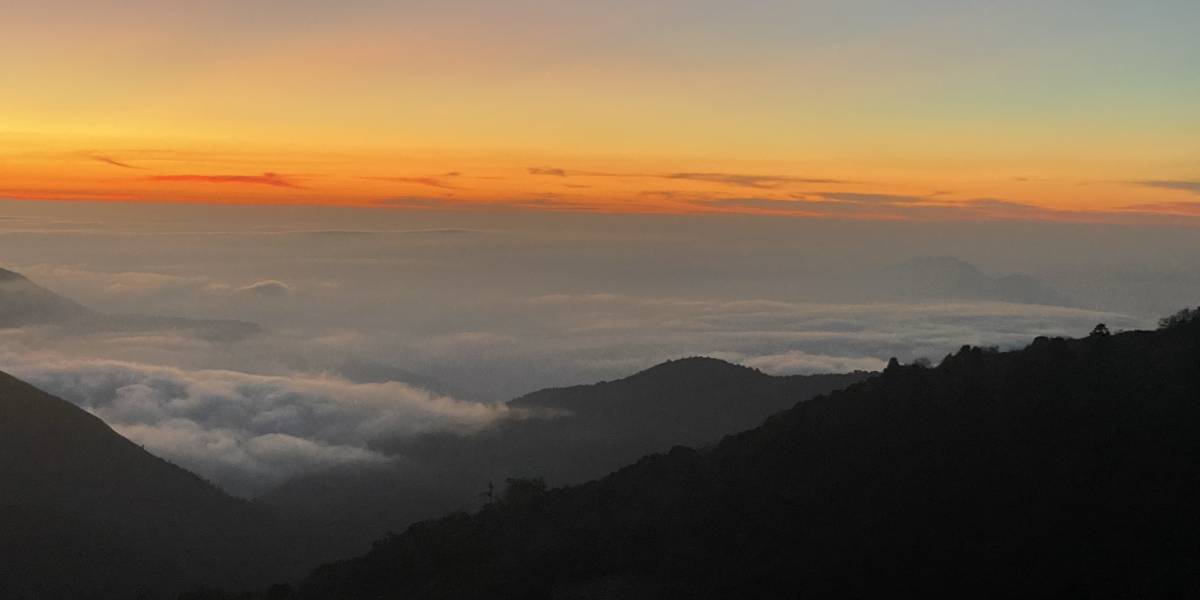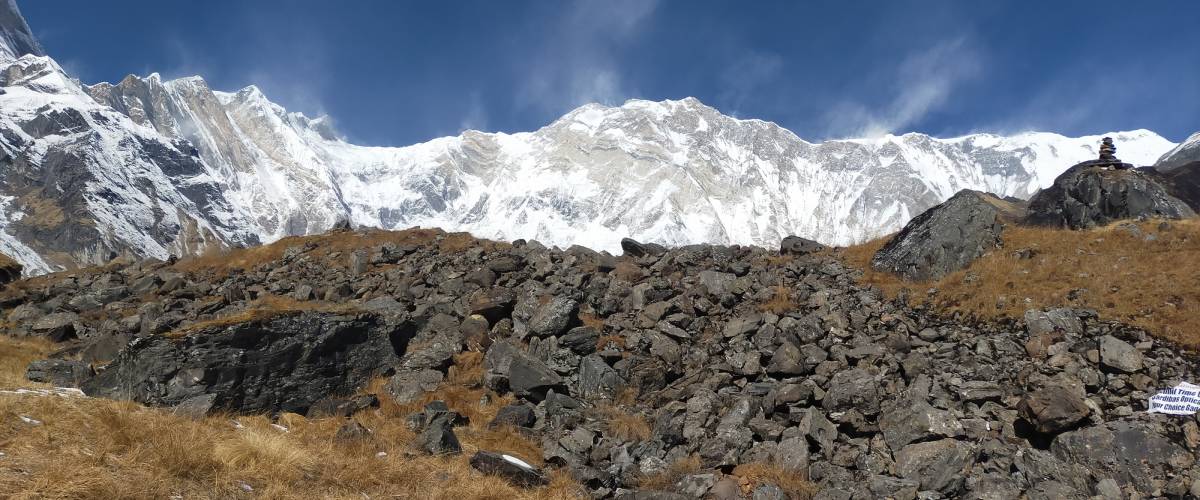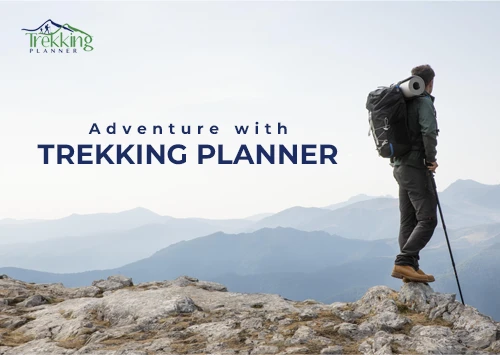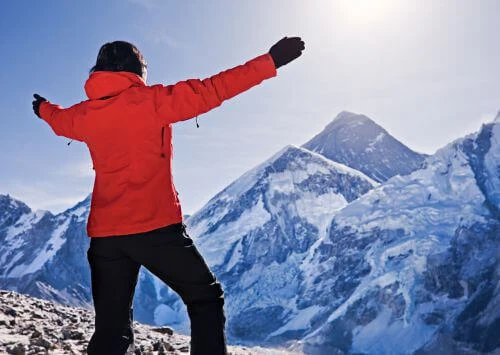Experience the Beauty of Annapurna Base Camp in October.
Are you looking for an adventure that will leave you awe-struck and rejuvenated? Look no further than the majestic Annapurna Base Camp. Nestled in the heart of the Himalayas, this trek offers a breathtaking view of snow-capped peaks, lush green forests, and charming local villages. And what is the best time to experience this beauty? October.
October offers the perfect weather for trekking, with clear skies and cool temperatures, making your journey all the more enjoyable. With our expert guides leading the way, you'll experience the unique culture and traditions of the local Gurung community in the Annapurna Region while immersing yourself in the natural beauty of the Himalayas.
So, pack your bags, put on your hiking boots, and prepare for the adventure of a lifetime. Experience the beauty of Annapurna Base Camp in October and create memories that will last a lifetime.

Highlights of Annapurna Base Camp Trek in October
- Walk through lush forests, terraced fields, and alpine landscapes all in one trek.
- Enjoy jaw-dropping views of Annapurna, Machapuchare (Fishtail), and surrounding peaks.
- You will experience the warm hospitality of Gurung and Magar villages along the route.
- Stay in cozy mountain teahouses with hearty meals and stunning backdrops.
- You can relax in the natural hot springs at Jhinu Danda after days of hiking.
- Catch unforgettable sunrises from Poon Hill or the base camp itself.
- Trek to a high-altitude destination without needing prior climbing experience.
Featured Trip: Annapurna Base Camp Short Trekking - 8 Days
5 Reasons to Do the Annapurna Base Camp Trek in October
1. Perfect Weather
October truly brings out the best trekking weather in Nepal. In October, you will experience the crisp and clean air and clear skies for days. Daytime temperatures are comfortably warm, making hiking enjoyable without getting too hot or sweaty. At night, it can get chilly, especially at higher altitudes, but nothing a good sleeping bag and a few layers can’t handle. Plus, no rain means no leeches lurking on the trail — just dry paths, golden sunshine, and fresh mountain air.
2. Stunning Mountain Visibility
This is when the Himalayas show off. October is famous for its crystal-clear skies, which means you get uninterrupted, picture-perfect views of giants like Annapurna, Dhaulagiri, and Machapuchare (Fishtail). The mountains look so close you’ll feel like you could reach out and touch them. Whether you're standing at a viewpoint like Poon Hill or soaking it all in from the base camp itself, the clarity and sharpness of the peaks in October are absolutely magical — it’s a dream come true for photographers and mountain lovers alike.
3. Lush Trails After Monsoon
Thanks to the recent monsoon rains, the entire trail is bursting with life in October. Forests are deep green, waterfalls are still flowing, and the valleys feel alive with fresh air and color. You’ll walk through bamboo groves, blooming flowers, and moss-covered rocks that seem like something out of a fantasy movie. If you love nature, you’ll love how vibrant and full of energy everything feels.
4. Festive Vibes
One of the best things about trekking in October is that it often lines up with Nepal’s biggest festivals — Dashain and Tihar. As you pass through villages, you will see houses decorated with flowers, hear music, or even get invited to share in the celebrations. You experience a sense of joy and community everywhere you go. It’s a great way to experience Nepal beyond just the mountains — you'll connect with its culture, its people, and its traditions in a way that feels personal and real.
5. Teahouses in Full Operation
Since October is peak trekking season, all the mountain lodges and teahouses are open and running at their best. That means more food options, hot showers in many places, and lively dining halls full of trekkers swapping stories from around the world. You won’t have to worry about finding a place to sleep or meals being limited — everything’s stocked and ready. Plus, the buzzing energy of fellow hikers adds to the overall experience. It’s a great time to make new friends and share the journey.
Why is October the Best time to visit Annapurna Base Camp?
The Annapurna Base Camp Trek is one of the most popular treks in the world, attracting thousands of trekkers every year. However, not all months are suitable for trekking in Annapurna Region. October is considered the best time to trek to Annapurna Base Camp due to several reasons.
Firstly, the weather is perfect during October. The monsoon season ends by September, leaving behind clear skies and cool temperatures. The days are sunny, and the nights are chilly, making it an ideal time for trekking. The views of the snow-capped peaks are crystal clear, and the air is fresh and pure.
Secondly, the autumn season is one of the most beautiful times to trek in the Annapurna Region. The forests are ablaze with colors, and the rhododendrons are in full bloom, creating a picturesque landscape. The trekking trails are usually dry, making it easier to walk without the fear of slipping.
Lastly, October is the peak season for trekking in the Annapurna Region. The tea houses are open, and the trails are bustling with other trekkers, making it a social experience. You'll get to meet people from different parts of the world, share stories, and make new friends.
Weather conditions at Annapurna Base Camp During October.
The weather in the Annapurna Region during October is ideal for trekking. The days are warm and sunny with temperatures ranging from 0°C to 12°C, and the nights are cool with temperatures dropping to around 0°C to 5°C. The skies are clear, offering spectacular views of the snow-capped peaks.
However, it's important to keep in mind that the weather in the mountains can be unpredictable. It's best to be prepared for any weather conditions, and it's recommended to bring warm clothes, rain gear, and a good quality sleeping bag.
Elevation (Approx.) | Daytime Temp | Nighttime Temp | Weather Conditions | Notes |
Pokhara (820m) | 20°C – 26°C | 12°C – 15°C | Warm, dry, sunny | Great for preparing gear |
Ghorepani (2,860m) | 10°C – 18°C | 4°C – 8°C | Cool mornings, pleasant days | Perfect for acclimatization |
Chhomrong (2,170m) | 12°C – 20°C | 5°C – 10°C | Mostly sunny, dry | Good place for rest |
Deurali (3,230m) | 8°C – 14°C | 0°C – 4°C | Chilly nights, clear skies | Cold starts in the morning |
ABC (4,130m) | 5°C – 10°C | -3°C – 0°C | Cold, crisp, great visibility | Bundle up at night! |
Quick Weather Tips for October Trekking:
- You must start early in the day to avoid the late afternoon chill.
- Always layer up so you can add or remove clothes as the temperature shifts.
- Pack a warm sleeping bag for cold nights, especially above 3,000 meters.
- You must use sunscreen and sunglasses — October sun can be harsh even if it's cool.
Trekking route to Annapurna Base Camp.
The trek to Annapurna Base Camp starts from Nayapul, which is a 1.5-hours drive from Pokhara. From Nayapul, the trail passes through several small villages, including Tikhedhunga, Ghorepani, Tadapani, and Chomrong, before reaching Annapurna Base Camp.
The trek is a mixture of ascending and descending trails, with some steep climbs and descents. The trail is well-maintained and easy to navigate, even for novice trekkers. The trek takes around 7 to 10 Days, depending on your pace and itinerary.

Simple 8 Day Itinerary for October Annapurna Base Camp Trek
Here’s a simple way to pace your trek in October:
- Day 1: Drive To Nyapaul 1,010m/3,314ft and start walk to Ghandruk village 1,930m/6332ft
- Day 2: Trek to Chomrong 2,170m/7120ft
- Day 3: Trek to Dovan 2,630m/8629ft
- Day 4: Trek To Machhapuchare Base Camp 3,700m/12139ft
- Day 5: Trek to Annapurna Base Camp (ABC) at 4,130m/13550ft
- Day 6: Trek from Base Camp to Bamboo 2,345m/7710ft
- Day 7: Trek to Jhinu Village 1,780m/5840ft with Hot Spring
- Day 8: Trek to Siwai and drive to Pokhara
Accommodation and Food options during the Annapurna Base Camp trek in October.
The Annapurna Base Camp Trek offers a variety of accommodation options, ranging from basic tea houses to luxury lodges. The tea houses provide basic accommodation facilities, including a bed, blankets, and a shared bathroom. The lodges offer more comfortable rooms with private bathrooms and hot showers.
The food options on the trek are also diverse, with a range of Nepali and Western dishes available. The tea houses and lodges offer a variety of vegetarian and non-vegetarian options, including dal bhat (a traditional Nepali meal), noodles, soups, and sandwiches. It's recommended to drink only boiled or bottled water during the trek to avoid any stomach problems.
Difficulty Level and Fitness Requirements During ABC trek in October.
The Annapurna Base Camp trek is a moderate trek suitable for trekkers with average fitness levels. It involves some steep climbs and descents, but the pace is slow, allowing enough time for acclimatization.
It's recommended to do some physical exercise before the trek to prepare your body for the trek. Cardiovascular exercises, such as running, cycling, or swimming, can help improve your endurance and stamina.
Recommended Read: Best Time for Annapurna Base Camp Trek
Altitude Sickness and Health Tips for October ABC Trek
Even though October weather is great, altitude sickness can still affect anyone. The key is to listen to your body. Drink plenty of water, eat well, and don’t push yourself too hard, especially on the first few days.
Altitude Sickness
When you’re trekking to Annapurna Base Camp, you’ll be climbing to pretty high altitudes — above 4,000 meters (13,000 feet). Even though October has great weather, altitude sickness can affect anyone, no matter how fit you are.
Altitude sickness happens because your body needs time to adjust to lower oxygen levels as you climb higher. The most common signs include:
- Headaches
- Feeling dizzy or lightheaded
- Nausea or vomiting
- Trouble sleeping or feeling very tired
If you notice any of these symptoms, the best thing to do is slow down, rest, and don’t push yourself too hard. Going up too fast increases your chances of getting sick. If symptoms get worse, it’s important to descend to a lower altitude quickly and seek medical help.
You can take Diamox to help prevent altitude sickness. But remember, it must be prescribed by the doctor. It’s important to talk with your doctor before taking any medicine to make sure it’s safe for you.
Health Tips for October
October weather is mostly stable and clear, but it can get quite cold at night, especially at higher elevations. Here are some health tips to keep your trek enjoyable and safe:
- Stay Hydrated: You must drink plenty of water throughout the day to help your body adjust and avoid dehydration.
- Eat Nutritious Food: You must always eat nutritious meals that are rich in carbs and proteins to keep your energy up.
- Dress in Layers: You must dress in layers so that you can add or remove easily according to the weather.
- Keep Warm at Night: Use a good sleeping bag and wear warm clothes to avoid getting cold and risking illness.
- Carry a Basic First Aid Kit: Include essentials like pain relievers, bandages, and blister care items for minor injuries.
- Rest Well: Don’t overexert yourself — listen to your body and take rest days when needed.
Permits and Fees required for the trek in October.
Before your trek, you must have the permits. There are two important permits required for Annapurna Base Camp. To trek to Annapurna Base Camp, you'll need to obtain the following permits:
- Annapurna Conservation Area Permit (ACAP): NPR 3,000 (~ USD 30) per person.
- Trekkers' Information Management System (TIMS) Card: NPR 2,000 (~ USD 20) per person.
These permits can be obtained from the Nepal Tourism Board or TAAN (Trekking Agencies Association of Nepal) in Kathmandu or Pokhara. It's important to carry these permits with you at all times during the trek. If you're trekking with a guide or agency, they’ll usually handle it for you.
Trekking planner Nepal arranges all the permits and the required documentation before starting the trek and provides all the designated fees so our clients wont have to rush here and there for the governmental works.
1. Annapurna Conservation Area Permit (ACAP)
This permit is required because the ABC trek goes through the protected Annapurna Conservation Area. The money you pay goes toward trail maintenance, local development, and conservation efforts. It's your way of giving back to the region you're exploring.
2. Trekkers’ Information Management System (TIMS) Card
This one helps authorities keep track of trekkers for safety reasons. If anything goes wrong or if you need help along the way, this card ensures your information is available. It’s kind of like your mountain safety pass.

Regulations Specific to October
The good news? There are no special restrictions in October. In fact, it’s one of the best months to trek — clear skies, dry trails, and stunning mountain views. But because October is such a popular trekking month, here are a few things you should be aware of:
- Always carry your permits: Rangers or checkpoints along the trail will ask to see them, especially during peak season. Keep them somewhere safe but easy to access — like in a dry zip-lock inside your daypack.
- Start early, arrive early: Since trails and teahouses can get crowded in October, it’s a smart move to begin your trek early in the morning and reach your destination before it fills up.
- Stick to the trail: Because the region is a protected area, it’s important to respect the environment. Don’t litter, and avoid taking shortcuts off the main path.
- Respect local customs: October might overlap with big festivals like Dashain or Tihar. If you're lucky, you’ll experience village celebrations — just be kind, observe respectfully, and follow your guide’s advice.
Packing Essentials/List for October Annapurna Base Camp Trek.
Here are some essential trekking gear that you should pack for the Annapurna Base Camp trek that the Nepal trekking planner recommends:
Clothing
- Base Layers: Lightweight thermal tops and bottoms. These keep you warm without making you sweat. Perfect for cold mornings and nights.
- Mid Layers: A fleece jacket or wool sweater to keep you cozy during breaks or cool evenings.
- Outer Layer: A waterproof and windproof jacket (preferably with a hood). October is mostly dry, but the weather in the mountains can change quickly.
- Trekking Pants: Comfortable, breathable, and quick-drying pants are best. Some like zip-off pants for versatility.
- T-shirts: Bring a couple of moisture-wicking shirts for daytime comfort.
- Warm Hat and Gloves: It can get cold at higher altitudes, so pack a wool or fleece hat and warm gloves.
- Sun Hat or Cap: To protect yourself from the strong sun during the day.
- Socks: Several pairs of good-quality trekking socks (wool or synthetic). Avoid cotton as it traps moisture.
- Sleepwear: Warm, comfortable clothes for sleeping — it can be cold in the teahouses.
Footwear
- Trekking Boots: Sturdy, waterproof boots with good ankle support. Make sure they’re well broken-in before the trek to avoid blisters.
- Camp Shoes or Sandals: Something lightweight and easy to slip on after a day of hiking to let your feet relax.
Gear & Accessories
- Backpack: A comfortable 40-50-liter backpack to carry your essentials.
- Daypack: A smaller bag for daily use to carry water, snacks, camera, and layers.
- Sleeping Bag: You must pack a warm sleeping bag rated for temperatures around -10°C to -15°C (14°F to 5°F) is recommended for cold nights.
- Trekking Poles: Pack trekking poles to reduce strain on your knees, especially on downhill sections.
- Water Bottles: Staying hydrated is vital. Bring reusable bottles or a hydration system.
- Water Purification: Put water purification tablets or filters to ensure safe drinking water.
- Headlamp: For early mornings, late evenings, or any nighttime needs. Don’t forget extra batteries.
- Sunglasses: UV-protected to shield your eyes from strong sun and glare off the snow.
- Sunscreen and Lip Balm: High SPF to protect your skin and lips from sunburn and wind.
- Camera or Smartphone: Carry camera or smartphone to capture the beautiful views.
Health & Safety
- First Aid Kit: Include basics like band-aids, pain relievers, blister pads, antiseptic cream, and any personal medication.
- Hand Sanitizer and Wet Wipes: Carry these for personal hygiene on the trail.
- Insect Repellent: Though October has fewer bugs, it’s good to have just in case.
- Altitude Sickness Medicine: Carry Diamox or similar medication only if it is prescribed my doctor.
It's recommended that you pack as light as possible and carry only the essentials. You can also rent or buy some of the items like down jackets and sleeping bags in Kathmandu or Pokhara.
Safety Measures and Tips That Trekking Planner Nepal Advise Before Starting the Trek.
Trekking in the mountains can be risky, and taking some safety measures is important to ensure a safe and enjoyable trek. Here are some tips to keep in mind:
- Nepal Trekking Planner Hires a licensed guide and porter.
- Stay hydrated and drink only boiled or bottled water.
- Follow the trail and avoid shortcuts.
- Acclimatize properly by taking rest days.
- Inform your guide or porter if you experience any symptoms of altitude sickness.
- Carry a good-quality map and a compass.
- Respect the local culture and traditions.
Tips for a Memorable ABC Trek Experience in October
Want to make your Annapurna Base Camp trek unforgettable? Here are a few tips from seasoned trekkers:
- Start Early Each Day: The mornings are clearer and quieter. Plus, you’ll beat the crowds to the best spots (and teahouse beds).
- Pack Light but Smart: Layers are your best friend. It might be warm during the day but freezing at night.
- Train Ahead: Even if it’s not the toughest trek, some cardio and leg training before you go will make a big difference.
- Hire a Guide or Porter (or Both): Not only does it support the local economy, but they’ll also help you navigate the trail and share local stories and culture.
- Stay Hydrated & Eat Well: Drink lots of water, enjoy the hearty dal bhat meals, and don’t skip snacks. You’ll need the energy!
- Take it Slow: Give your body time to adjust to the altitude. Rushing only increases the chance of altitude sickness.
- Capture the Moments: Bring a good camera or make space on your phone. October skies and those towering peaks are made for photography.
4 Reasons to Avoid the Annapurna Base Camp Trek in October
Although october is the best time to trek Annapurna Base Camp trek, there are few reasons due to that you should avoid. Here’s what you should consider:
- Crowded Trails: It is the most popular trekking month, so you can expect to share the trail with a lot of other trekkers, especially at lodges and viewpoints.
- Accommodation Fills Up Fast: You might struggle to find rooms at busy spots unless you book early or reach your destination ahead of the crowd.
- Price Hikes: With high demand comes slightly higher prices for rooms, guides, and even transport.
- Less Solitude: If you’re looking for quiet mountain introspection, October might feel a bit too busy.
Conclusion for Trekking in October from Trekking Planner Nepal.
The Annapurna Base Camp Trek in October is an unforgettable experience that combines natural beauty, cultural immersion, and adventure. The trek is a must-do for any adventure enthusiast with its perfect weather conditions, stunning landscapes, and diverse accommodation and food options. So pack your bags, put on your hiking boots, and prepare for the adventure of a lifetime. Experience the beauty of Annapurna Base Camp in October and create memories that will last a lifetime.
4 Close Alternatives to the Annapurna Base Camp Trek During October
If you love trekking in Nepal and want quite, short or off-the-beaten-path during october. Here are some close alternatives to the Annapurna Base Camp trek. Each one offers its own charm, stunning views, and memorable experience.

1. Mardi Himal Trekking
Duration: 10 days
Trip Grade: Moderate
Maximum Altitude: 4450 m
Best Time: March to May and September to December
The Mardi Himal Trek is perfect if you want spectacular views without the crowds. It’s like ABC’s peaceful cousin. The trail takes you through dense forests, ridges with sweeping views, and up to Mardi Himal Base Camp — right opposite the massive Machapuchare (Fishtail) peak.
- It’s less commercialized, so you’ll enjoy more solitude.
- The trail is well-marked but feels wilder and more intimate.
- Sunrises from High Camp are absolutely breathtaking.
2. Ghorepani Poon Hill Trekking
Duration: 10 Days
Trip Grade: Easy
Maximum Altitude: 3,210 m
Best Time: March to May and September to December
Looking for a shorter trek with big rewards? The Ghorepani Poon Hill trekking is ideal for beginners or anyone short on time. It offers one of the best panoramic sunrises over the Annapurna and Dhaulagiri ranges.
- You’ll pass through charming villages and blooming rhododendron forests.
- The sunrise view from Poon Hill is worth waking up early for — golden peaks stretching across the horizon.
- The trail is well-maintained, with plenty of cozy teahouses.
Also has an option as 5 days Ghorepani poonhill trekking
4. Annapurna Circuit Trekking
Duration: 17 Days
Trip Grade: Moderate
Maximum Altitude: 5,416 m
Best Time: March to May and September to November
If you want a longer and more diverse trekking experience, the Annapurna Circuit trekking is a classic route. It takes you around the entire Annapurna range — from lush green valleys to the high, windswept pass of Thorong La.
- You’ll experience dramatic landscape changes every day.
- Explore villages influenced by both Hindu and Tibetan Buddhist culture.
- Cross one of the world’s highest trekking passes, Thorong La — an epic accomplishment.
Explore Annapurna Region Trekking Packages
- Ghorepani Poonhill Trekking-5 Days
- Mardi Himal Base Camp Short Trek: 5 Days
- Annapurna Skyline Trek - 6 Days
- Ghorepani Poon Hill Trek-6 Days
- Mardi Himal Trekking: 10 Days
- Annapurna Circuit Short Trek-10 Days
- Annapurna Luxury Lodge Trekking -10 Days
- Annapurna Panorama Trekking-11 Days
- Annapurna Semi Circuit Trekking-15 Days
- Khopra Poon Hill Trekking-15 Days





